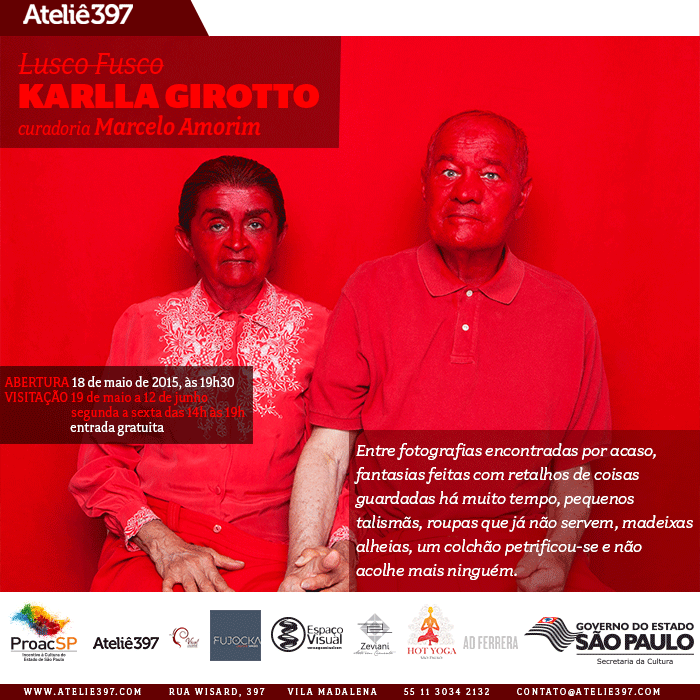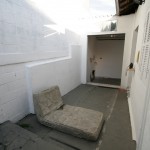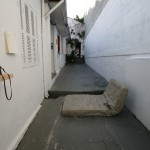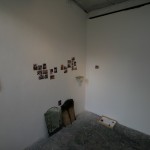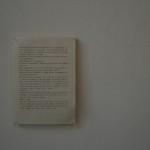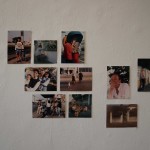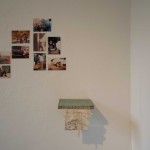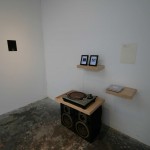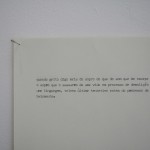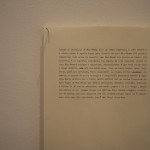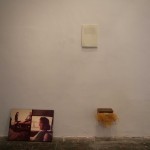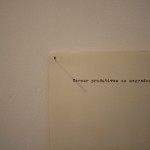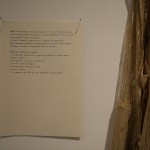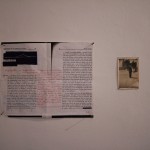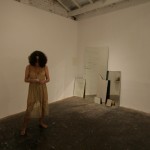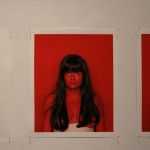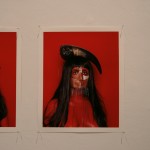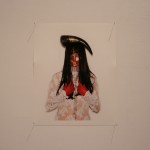Lusco Fusco | Karlla Girotto
{English below}
Dia 18 de maio, segunda-feira, o Ateliê397 com apoio da Secretaria de Cultura do Estado de São Paulo – via ProAC, inaugura a exposição “Lusco Fusco”, da artista Karlla Girotto, com curadoria de Marcelo Amorim. A mostra vai ocupar as duas salas da galeria, e terá uma instalação na primeira delas, constituída por um conjunto de objetos, fotos, roupas e acessórios – como uma constelação na qual os objetos, como estrelas, brilham em intensidades diferentes, avizinham-se, nascem ou desaparecem, formando conjuntos vagos e abertos. Na segunda sala, a artista vai realizar, diariamente e durante todo o período da exposição, uma performance na qual o público é convidado a transformá-la, através dos acessórios disponíveis, para uma dança a dois. Um aparelho de som abrigará um conjunto de discos cujo conteúdo remete à trilhas sonoras de filmes e cujos nomes, à emoções e ambientes: brutalidade, vida, alegria, arrebatamento, dentre outros. A trilha para a ação ficará a cargo do participante.
“Lusco Fusco” faz referência direta ao período entre o fim do dia e o começo da noite, o instante crepuscular, que, por ainda não ter estrelas, mas também não mais a luz do sol, suspende temporariamente as noções de tempo e espaço que norteiam as vidas na Terra. É típico do lusco fusco não produzir sombra, retirar as referências cardeais e, como os animais de hábitos diurnos já estão recolhidos e os noturnos ainda não começaram sua movimentação, instalar uma suspensão. Há nisso alguma estranheza que torna o intervalo real.
Os objetos e fotos da primeira sala, para Karlla Girotto, dão conta de elaborar uma travessia entre o participante que chega e a artista, que estará todos os dias no espaço expositivo, justamente porque remetem a acontecimentos anteriores na vida desta, questionando seu passado: o que pode uma herança, o que é o tempo e quais as ficções possíveis sobre a sua passagem. “Lusco Fusco” propõe uma performatização do intervalo entre a revolução e a melancolia. Revolução na literalidade do ato ou efeito de revolver o que estava sereno e a melancolia, que não é tristeza, tampouco depressão, mas sim a fragilidade que permite a passagem de estados emergentes em que algo de outra grandeza se instaura e se faz tarefa a se dar conta.
Se certos elementos que remetem à memória são transfigurados pela intervenção da artista e passam a incorporar outras qualidades, a dança-ação, na qual o visitante é implicado, faz referência ao processo de subjetivação e sua relação intrínseca com um outro. O publico é provocado a assumir o papel de performer que negocia a construção da experiência do intervalo proposto pela artista.
Karlla Girotto é artista e pesquisadora nas áreas de artes visuais, moda e performance. É Mestranda em Psicologia Clinica pelo Núcleo de Estudos da Subjetividade (PUC/SP) sob orientação da Profa. Dra. Suely Rolnik. Seus principais eixos de pesquisa são: modos de existência como produção artística e suas linhas fronteiriças entre performance, moda e vida nos processos de criação e produção de subjetividade. Entre suas atividades coordena o grupo de estudos e pesquisa em moda e design G>E sediado na Casa do Povo onde também está situado o seu ateliê.
Serviço:
Lusco Fusco, de Karla Girotto
Abertura dia 18 de maio a partir das 19H.
Visitação:
19 de maio a 12 de junho de 2015
Segunda a sexta-feira, das 14 às 19H
Programação gratuita.
Ateliê 397 – Rua Wisard, 397
Telefone: 3034-2132
www.ateliê397.com
Lusco Fusco
por Marcelo Amorim“O coração tem pouca ironia de tardinha.
Segredos carnais à flor da pele
Poemas descarnados aguardando
O coração tem pouquíssimo fôlego na piscina
Nos quintais dispara úmido
Nas salas fechadas cuida das buzinas
A vida se encarrega das janelas
Mas acaba descendo em correria
Não cabe Não suporta Não tem peso”
(Ana Cristina Cesar)Entre fotografias encontradas por acaso, fantasias feitas com retalhos de coisas guardadas há muito tempo, pequenos talismãs, roupas que já não servem e madeixas alheias, um colchão petrificou-se e não acolhe mais ninguém.
Um velho colchão guarda o peso dos corpos, o delírio das febres, a nata dos sonhos, o suor dos amantes. Ele é um monumento às coisas mais importantes e voláteis.
Eu guardei por tanto tempo pequenas coisas que tinham esse tamanho de importância: dentes de leite, medalhas que se rompiam no peito de alguém e que eu encontrava na rua. Como um aborígene na Austrália, quando criança eu movia os pequenos ossos no terreiro da casa e pensava que, com minha ação, continentes se moviam e o vento podia ser controlado. O pensamento mágico que ciência alguma jamais conseguiu contradizer em sua eficácia.
As coisas fazem sentido enquanto lhes atribuímos valor. O valor não está nas coisas, mas nas camadas que lhes acrescentamos. Destituídas desse empenho, dessa camada simbólica, tornam-se inúteis, sem sentido. Pintar de vermelho, para a artista, é sinalizar essa camada, torná-la visível e criar um invólucro.
Chama-se exoesqueleto a membrana que cobre o corpo de certos animais. Resistente e flexível, ela oferece proteção aos orgãos internos, suporte para os músculos e evita que a umidade se perca. Apesar das vantagens que oferece, o exoesqueleto é um fator limitante ao crescimento dos animais. É preciso deixá-lo para se aumentar de tamanho. O invólucro sem o corpo congela. Não serve mais. Guarda ali, no entanto, os contornos exatos do corpo que o animava.
As larvas da cigarra podem ficar 17 anos sob a terra. No período quente do ano, as ninfas emergem, sofrem uma metamorfose e tornam-se finalmente cigarras. Naquele período, de canto ensurdecedor e acasalamento, põe ovos e morrem. De um processo de anos, resta apenas sua casca, tais quais aquelas que as crianças de antigamente colecionavam em caixas de fósforo, como troféus das tardes de verão.
O lusco fusco acontece à tardinha, na hora dos mágicos cansaços, quando se pensa no dia que passou e se prepara para o desamparo da noite. A exposição é essa pausa. Fala da contínua necessidade de ressignificar a própria vida, pra que não congele, e do vazio entre o pré-existente e o que está por vir. É uma coleção de amuletos que comunicam poderes sobrenaturais. É também um dossiê, uma compilação de provas de momentos pretéritos, formas petrificadas que não funcionam mais e, no entanto, condensam em si longos processos de vida.
A coleção de esqueletos só prova que a vida é fluxo. Fazer arte é um pulo no escuro, é manter-se vulnerável, é revolver o estanque. A artista disse que vai continuar arriscando até acertar (sendo que o acerto é o risco em si). Ela permanecerá durante um mês na sala, esperando por um par para dançar. Você poderá vestí-la como desejar. Cabe ao outro adicionar essa camada. Ela participa de um concurso de dança, concorrendo apenas consigo mesma. Uma maratona de dança e de resistência pela própria sobrevivência, até o limite de suas forças, sob um facho de luz. Ao fim, não ficamos sabendo quem ganha o páreo, e pouco importa. O apresentador termina, grandiloquente, falando ao microfone que os dançarinos seguem com garra e esperança e que a grande dança da vida não termina.
Lusco Fusco.
by Karlla Girotto
Ateliê397 with the support of the Secretaria de Cultura do Estado de São Paulo – through ProAC, opens on May 18, Monday, the exhibition “Lusco Fusco”, by artist Karlla Girotto, curated by Marcelo Amorim. The show will occupy both gallery rooms, having an installation on the first one, made up by a group of objects, pictures, clothes and accessories – as a constellation in which the objects, as stars, shine in different intensities, approach to each other, are born or disappear, forming vague and wide sets. In the second room, the artist will be holding, daily and during the entire period of the exhibition, a performance in which the audience is invited to transform her, through the accessories available, for a two people dance. A sound device will play records which content alludes to movie soundtracks and its names to emotions and moods: brutality, life, joy, rapture, among others. The participant will choose the action’s soundtrack.
“Lusco Fusco” makes a direct reference to the period between the end of the day, and the beginning of the night, the twilight moment, which, for not having stars and sunlight yet, the notions of time and space which guide the lives on Earth is temporarily suspended.. It is typical of the twilight to not produce any shade, removing cardinal references and, as the daylight animals are already in their shelters and the nocturnal are not moving yet, to install a suspension. There is some kind of strangeness that makes real the interval.
The objects and pictures of the first room, for Karlla Girotto, build a travessiabetween the participant who arrives, and the artist, who is staying every day in the exhibition space. Precisely because they refer to previous events in her life, asking about her past: what a heritage could change, what time is it, and what are the possible fictions about their passage. “Lusco Fusco” proposes an action of the interlude between the revolution and the melancholy. Revolution in the literacy of the act or effect of moving what was quite, and melancholy, different from sadness or neither depression but fragility, that allows the passage of emerging states in which something of another greatness is established and works for existence.
If certain elements that refer to memory are transfigured by the artist intervention and start to hold other characteristics, the dance-action, in which the visitor is implied, makes reference to the process of becoming subjective and its inherent relationship with one other. The audience is encouraged to assume the performer role which deals with the building experience of the lapse proposed by the artist.
Karlla Girotto is an artist and researcher in the visual arts, fashion and performance fields. Master in Clinic Psychology by the Núcleo de Estudos da Subjetividade (PUC/SP) under the supervision of Dra. Suely Rolnik. Her principal research interests are: ways of existence as an artist`s production and their frontiers between performance, fashion and life in the creative process and subjectivity production. Among her activities, she coordinates the group of studies and research in fashion and design G>E based in Casa do Povo, where is also located her studio.
Service:
Lusco Fusco by Karlla Girotto
Opens May 18 from 7p.m.
Visits:
May 19 to June 12, 2015
Monday to Friday, 2p.m. – 7p.m.
Ateliê 397 – Rua Wisard, 397
Telefone: 3034-2132
www.ateliê397.com
Lusco-Fusco
by Marcelo Amorim
“A heart has little irony in the early evening.
Carnal secrets lurking on the surface of the skin
Stripped-of-flesh poems waiting
The heart is short of breath in the pool
It beats fast and damp in the backyards
In closed rooms, it takes care of the horns
Life takes care of the windows
But ends up going down at a run
It does not fit, it does not resist, it has no weight”
(Ana Cristina Cesar)Among photographs found by chance, costumes made of patches of things that have been stored for a long time, small talismans, clothes that no longer fit and someone’s hair, a mattress petrified and does not welcome anyone anymore.
An old mattress keeps the weight of the bodies, the delirium of high fevers, the cream of dreams, the sweat of lovers. It is a monument to the most important and volatile things.
I kept for so long little things that were so important: baby teeth, medals that would snap from someone’s chest and I would find on the street. Like an Aboriginal Australian, as a child I would move the small bones in the backyard of the house and think that this would cause continents to move and the wind to be controlled. Magical thinking whose effectiveness science has never been able to contradict.
Things make sense as we place a value on them. The value does not lie in the actual object, but rather in the layers we add to it. Deprived of this effort and this symbolic layer, an object becomes useless, meaningless. For the artist, painting in red signals that layer, makes it visible and creates an enclosure.
The membrane that covers the body of certain animals is called exoskeleton. Resistant and flexible, it offers protection to internal organs, support for the muscles and prevents moisture from being lost. Despite the advantages it offers, the exoskeleton is a limiting factor to the growth of animals. It must be left behind in order to increase in size. The casing would freeze without the body. It no longer fits. However, the shape of the body that once dwelled there is still visible.
The cicada larvae can stay 17 years under the ground. During the warm season of the year, the nymphs emerge, undergo metamorphosis and finally become cicadas. In that period – during which they produce a very loud sound and mate – they lay eggs and die. All that is left from a process of many years is a shell – just like those shells children from the old days would collect in matchboxes as trophies of summer afternoons.
The twilight occurs in the evening, at the time of magical weariness when we think of the day that has just ended and prepare for the evening’s helplessness. The exhibition is this break. It speaks of the constant need to give a new meaning to one’s life so that it will not freeze and of the gap between what is known and what is to come. It is a collection of amulets that convey supernatural powers. It is also a dossier, a collection of evidence of the past, petrified forms that no longer work and, however, encapsulate long life processes.
The collection of skeletons just proves that life is a flow. Making art is a leap in the dark; it means to remain vulnerable and stir what once was stagnant. The artist said that she will continue to take risks until she is successful (and success is the risk itself). She will stay in the room for a month, waiting for a partner to dance. You will be able to dress her as you wish. It is up to the other to add the layer. She participates in a dance contest and competes only with herself. A dance and endurance marathon where her own survival is at stake, to the limit of her abilities, under a spotlight. In the end, we don’t know who the winner is, and it doesn’t matter. The host ends by saying pompously on the microphone that the dancers should continue with hope and determination, and that the big dance of life never ends.
